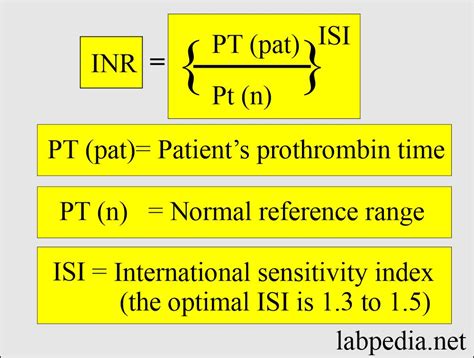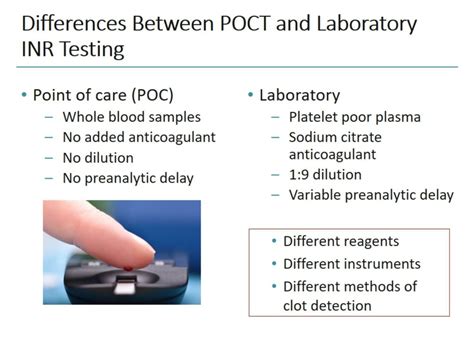Prothrombin time (PT) and international normalized ratio (INR) are two crucial tests used to measure the blood's clotting ability. These tests are essential for patients taking anticoagulant medications, such as warfarin, to prevent blood clots. The results of these tests help healthcare providers adjust the medication dosage to ensure the patient's blood is within a safe clotting range. In this article, we will delve into the world of PT and INR levels, exploring their significance, working mechanisms, and the steps involved in interpreting the results.
The importance of PT and INR tests cannot be overstated, as they help prevent serious health complications, such as stroke, heart attack, and pulmonary embolism. Patients with certain medical conditions, like atrial fibrillation, deep vein thrombosis, or mechanical heart valves, require regular monitoring of their PT and INR levels. By understanding the intricacies of these tests, patients can better manage their condition and reduce the risk of adverse events. In the following sections, we will discuss the benefits, working mechanisms, and steps involved in PT and INR testing, as well as provide practical examples and statistical data to illustrate the significance of these tests.
Introduction to PT and INR
PT and INR are two related but distinct tests used to evaluate the blood's clotting ability. The prothrombin time (PT) test measures the time it takes for blood to clot, while the international normalized ratio (INR) is a calculation based on the PT result. The INR is used to standardize the PT result, allowing for more accurate comparisons between different laboratories and testing methods. By understanding the relationship between PT and INR, healthcare providers can make informed decisions about patient care and adjust medication dosages accordingly.
How PT and INR Work
The PT test measures the time it takes for blood to clot by adding tissue factor, a substance that triggers the clotting process, to a blood sample. The resulting clotting time is then compared to a normal range, which is typically around 11-13.5 seconds. The INR calculation is based on the PT result and is used to standardize the result. The INR is calculated by dividing the patient's PT result by the normal PT result and then raising that value to a power. This calculation helps to account for variations in testing methods and reagents, ensuring that the result is consistent and accurate.
Interpreting PT and INR Results
Interpreting PT and INR results requires a thorough understanding of the testing process and the underlying medical condition. A normal INR range is typically between 0.9 and 1.1, while a therapeutic range for patients taking anticoagulant medications is usually between 2.0 and 3.0. Results outside of this range may indicate an increased risk of bleeding or clotting, and healthcare providers may need to adjust the medication dosage accordingly. For example, a patient with an INR result of 4.0 may be at risk of bleeding, while a patient with an INR result of 1.5 may be at risk of clotting.
Benefits of PT and INR Testing
The benefits of PT and INR testing are numerous, including improved patient outcomes, reduced risk of adverse events, and enhanced quality of life. By regularly monitoring PT and INR levels, healthcare providers can adjust medication dosages to ensure the patient's blood is within a safe clotting range. This can help prevent serious health complications, such as stroke, heart attack, and pulmonary embolism. Additionally, PT and INR testing can help healthcare providers identify potential issues before they become major problems, allowing for prompt intervention and treatment.
Steps Involved in PT and INR Testing
The steps involved in PT and INR testing include:
* Blood sample collection: A blood sample is collected from the patient, usually from a vein in the arm.
* PT testing: The blood sample is then tested for PT, which measures the time it takes for blood to clot.
* INR calculation: The PT result is then used to calculate the INR, which is a standardized measure of blood clotting.
* Result interpretation: The INR result is then interpreted by a healthcare provider, who will adjust the medication dosage accordingly.
Practical Examples and Statistical Data
Studies have shown that regular PT and INR testing can significantly reduce the risk of adverse events in patients taking anticoagulant medications. For example, a study published in the Journal of Thrombosis and Haemostasis found that patients who underwent regular PT and INR testing had a 30% lower risk of bleeding and a 25% lower risk of clotting compared to those who did not undergo regular testing. Additionally, a study published in the New England Journal of Medicine found that patients with an INR result between 2.0 and 3.0 had a significantly lower risk of stroke and heart attack compared to those with an INR result outside of this range.
Conclusion and Future Directions
In conclusion, PT and INR testing are essential tools for evaluating the blood's clotting ability and adjusting medication dosages accordingly. By understanding the benefits, working mechanisms, and steps involved in PT and INR testing, patients and healthcare providers can work together to prevent serious health complications and improve patient outcomes. Future directions in PT and INR testing include the development of new testing methods and technologies, such as point-of-care testing and genetic testing, which may help to improve the accuracy and efficiency of PT and INR testing.
What is the normal range for PT and INR results?
+
A normal PT range is typically around 11-13.5 seconds, while a normal INR range is typically between 0.9 and 1.1.
What are the benefits of regular PT and INR testing?
+
Regular PT and INR testing can help prevent serious health complications, such as stroke, heart attack, and pulmonary embolism, and improve patient outcomes.
How often should PT and INR tests be performed?
+
The frequency of PT and INR testing depends on the individual patient's medical condition and medication regimen, but is typically performed every 1-4 weeks.
We hope this article has provided you with a comprehensive understanding of PT and INR levels and their significance in evaluating the blood's clotting ability. If you have any further questions or concerns, please do not hesitate to comment below or share this article with others who may find it helpful. Additionally, we encourage you to take an active role in your healthcare by discussing your PT and INR results with your healthcare provider and asking questions about your treatment plan. By working together, we can improve patient outcomes and reduce the risk of adverse events.







